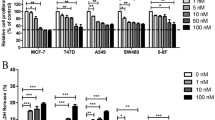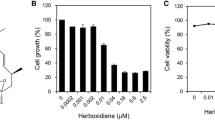Abstract
Purpose
This study was to evaluate the correlation of two important strategies, namely, cell cycle proliferation arrest and anti-angiogenesis. We chose fascaplysin, a marine natural product with selective CDK4 selective inhibition activity, to study its potential anti-angiogenesis effects in vivo and in vitro.
Methods
Chorioallantoic membrane (CAM) assay was initially used as an in vivo approach to evaluate anti-angiogenic activity of fascaplysin. In addition, human umbilical vein endothelial cell (HUVEC) line was used to further confirm the anti-angiogenic activity of fascaplysin in vitro. To explore the mechanism of anti-angiogenesis, we examined the effect of fascaplysin on vascular endothelial growth factor (VEGF) expression and secretion by hepatocarcinoma cells BeL-7402.
Results
The results of CAM assay suggested fascaplysin inhibited capillary plexus formation in a dose-dependent manner and suppressed VEGF in cross section. Moreover, the in vitro assay also confirmed that fascaplysin provided selective inhibition of endothelial cells proliferation towards tumor cells in low concentration. The immunocytochemical staining and ELISA verified fascaplysin could inhibit VEGF expression and secretion by BeL-7402.
Conclusions
These findings strongly suggest that fascaplysin is a natural angiogenesis inhibitor.








Similar content being viewed by others
References
Okamoto A, Demetrick DJ, Spillare EA, Hagiwara K, Hussain SP, Bennett WP, Forrester K, Gerwin B, Serrano M, Beach DH (1994) Mutations and altered expression of p16INK4A in human cancer. Proc Natl Acad Sci USA 91(23):11045–11049
Kim H, Ham EK, Kim YI, Chi JG, Lee HS, Park SH, Jung YM, Myung NK, Lee MJ, Jang JJ (1998) Overexpression of cyclin D1 and cdk4 in tumorigenesis of sporadic hepatoblastomas. Cancer Lett 131(2):177–183
Fry DW, Bedford DC, Harvey PH, Fritsch A, Keller PR, Wu Z, Dobrusin E, Leopold WR, Fattaey A, Garrett MD (2001) Cell cycle and biochemical effects of PD 0183812. A potent inhibitor of the cyclin D-dependent kinases CDK4 and CDK6. J Biol Chem 276(20):16617–16623
Garrett MD, Fattaey A (1999) CDK inhibition and cancer therapy. Curr Opin Genet Dev 9(1):104–111
Roll DM, Ireland CM, Lu HSM, Clardy J (1988) Fascaplysin, an unusual antimicrobial pigment from the marine sponge Fascaplysinopsis sp. J Org Chem 53:3276–3278
Soni R, Muller L, Furet P, Schoepfer J, Stephan C, Zumstein-Mecker S, Fretz H, Chaudhuri B (2000) Inhibition of cyclin-dependent kinase 4 (Cdk4) by fascaplysin, a marine natural product. Biochem Biophys Res Commun 275(3):877–884
Radchenko OS, Novikov VL, Elyakov GB (1997) A simple and practical approach to the synthesis of the marine sponge pigment fascaplysin and related compounds. Tetrahedron Lett 38:5339–5342
Huwe A, Mazitschek R, Giannis A (2003) Small molecules as inhibitors of cyclin-dependent kinases. Angew Chem Int Ed Engl 42(19):2122–2138
Senderowicz AM (2003) Small-molecule cyclin-dependent kinase modulators. Oncogene 22(42):6609–6620
Klagsbrun M, Moses MA (1999) Molecular angiogenesis. Chem Biol 6:217–224
Mise M, Arii S, Higashituji H, Furutani M, Niwano M, Harada T, Ishigami S, Toda Y, Nakayama H, Fukumoto M, Fujita J, Imamura M (1996) Clinical significance of vascular endothelial growth factor and basic fibroblast growth factor gene expression in liver tumor. Hepatology 23:455–464
Richardson M, Singh G (2003) Observations on the use of the avian chorioallantoic membrane (CAM) model in investigations into angiogenesis. Curr Drug Targets Cardiovasc Haematol Disord 3(2):155–185
Ribatti D, Gualandris A, Bastaki M, Vacca A, Iurlaro M, Roncali L, Presta M (1997) New model for the study of angiogenesis and antiangiogenesis in the chick embryo chorioallantoic membrane: the gelatin sponge/chorioallantoic membrane assay. J Vasc Res 34(6):455–463
Mosmann T (1983) Rapid colorimetric assay for cellular growth and survival: application to proliferation and cytotoxicity assays. J Immunol Methods 65(1–2):55–63
Folkman J (1974) Proceedings: tumor angiogenesis factor. Cancer Res 34:2109–2113
Ingber DE (1992) Extracellular matrix as a solid-state regulator in angiogenesis: identification of new targets for anti-cancer therapy. Semin Cancer Biol 3(2):57–63
Xu G, Pan J, Martin C, Yeung SJ (2001) Angiogenesis inhibition in the in vivo antineoplastic effect of manumycin and paclitaxel against anaplastic thyroid carcinoma. J Clin Endocrinol Metab 86(4):1769–1777
Nuijen B, Bouma M, Manada C, Jimeno JM, Schellens JH, Bult A, Beijnen JH (2000) Pharmaceutical development of anticancer agents derived from marine sources. Anticancer Drugs 11(10):793–811
Cragg GM, Newman DJ (1999) Discovery and development of antineoplastic agents from natural sources. Cancer Invest 17(2):153–163
Schwartsmann G (2000) Marine organisms and other novel natural sources of new cancer drugs. Ann Oncol 11:235–243
Folkman J (1985) Tumor angiogenesis. Adv Cancer Res 43:175–203
Hanahan D, Folkman J (1996) Patterns and emerging mechanisms of the angiogenic switch during tumorigenesis. Cell 86(3):353–364
Boehm T, Folkman J, Browder T, O’Reilly MS (1997) Antiangiogenic therapy of experimental cancer does not induce acquired drug resistance. Nature 390(6658):404–407
Acknowledgments
This work was supported by grants from Program for New Century Excellent Talents in University (NECT-04-0555), NSFC project (20472040), and Ningbo City Science and Technology Project (2003C10003).
Author information
Authors and Affiliations
Corresponding author
Rights and permissions
About this article
Cite this article
Lin, J., Yan, XJ. & Chen, HM. Fascaplysin, a selective CDK4 inhibitor, exhibit anti-angiogenic activity in vitro and in vivo. Cancer Chemother Pharmacol 59, 439–445 (2007). https://doi.org/10.1007/s00280-006-0282-x
Received:
Accepted:
Published:
Issue Date:
DOI: https://doi.org/10.1007/s00280-006-0282-x




